Chinese multiple launch rocket systems. Part II
In the second half of the eighties, the Sichuan Aerospace Industry Company (SCAIC) began the development of unguided rockets for multiple rocket launchers under the general name Weishi (Defender). They should have been distinguished from previous missiles by a large caliber, a greater range, and greater power. Tests of the first finished RSZO family called WS-1 began in 1990 year.
The basis of the WS-1 complex was the eponymous rocket projectile caliber 302 millimeter. With a length of about 4,7 meter rocket weighed 520-530 kilogram, depending on the type of applied head. Like all rocket salvo systems, the WS-1 was equipped with a solid-fuel engine. The engine model FG-42 provides the maximum flight speed of the order of 1300 meters per second. In the course of the flight, the ballistic trajectory rocket rose to an altitude up to 30 kilometers. The firing range lay in the range from 40 to 100 kilometers. The WS-1 rocket delivered to the target a fragmentation or cluster warhead weighing 150 kg. Stabilization in flight was carried out using four planes in the tail of the rocket. These stabilizers were located at an angle to the axis of the projectile, which led to unwinding during the flight.
The WS-1 MLRS combat vehicle could be mounted on the basis of any suitable three-axle truck. On the frame of the car, immediately behind the standard cabin, an additional compartment was installed to accommodate the equipment, and a launcher was mounted above the rear axles. The latter was a block of four tubular guides (2x2) installed on a swing-up device. Horizontal guidance was possible within 30 ° from the axis of the machine in both directions. The maximum elevation angle is 60 degrees. Turning and raising the guides was carried out hydraulically, but if necessary, you could use mechanisms with manual transmission. Similarly, the situation was with the outriggers who held the car during the shooting. In the event of a hydraulic system failure, the transfer time of the vehicle from the traveling to the combat position increased significantly. Without any technical problems, a three-person calculation should have performed this procedure in 18-20 minutes. A relatively long time to transfer to a combat or marching position was due to the complexity of all actions and a long range, which made it possible not to rush too much with preparation.
However, for the long range had to pay some features of operation and shooting. Firstly, the WS-1 combat vehicle carried only four unguided missiles, which, when stabilized by rotation, did not give a high effectiveness of the strike with one volley. Secondly, a separate transport-loading machine was required, with which it took at least five minutes to prepare one shell for firing. Finally, the need for a massive strike by the forces of several batteries was almost not compensated by the large mass of warhead of each rocket. Even with a circular deviation of about one percent from the firing range, the dispersion of shells was too large to effectively hit targets. For these reasons, it was decided to limit the trial operation of several batteries. MLRS WS-1 is not officially accepted into service.
Already in 1993, a new version of the Weishi family salvo fire system, WS-1B, appeared. The eponymous missile received a new engine of greater power, thanks to which the maximum flight speed increased (about 1500 m / s) and, as a result, the maximum range. At the same time, the rocket weighs up to a kilogram of 705-730. WS-1B MLRS could hit targets at 80-180 kilometers. In addition, a more powerful engine allowed to make a new head. In addition to the standard high-explosive fragmentation and cassette, fragmentation appeared with an increased number of ready-made destructive elements. According to unconfirmed data, the volume-detonating part was developed. After the upgrade, the accuracy rates deteriorated slightly. The QUO now ranged from 1 to 1,25 percent of firing range. In this case, the mass of the head part remained the same.
It is quite obvious that the WS-1B MLRS differed from the original WS-1 only in its greater range. There were no other useful innovations, and the accuracy deteriorated. For this reason, the PLA did not accept the WS-1B armament. But these cars are interested in foreign buyers. In the late nineties, Turkey acquired several WS-1 MLRS batteries, which received the local designation Kasigra. A little later, Ankara and Beijing agreed to deploy a licensed production of WS-1B systems, renamed Jaguar. The rest of the countries showed their interest, but it never came to supplies.
The latest member of the Weishi family at the moment is the WS-2 MLRS. Once again, increased the size of the rocket, in particular, the caliber has grown to 400 millimeters. The range of flight of new missiles increased to 200 kilometers. In addition, further development of WS-2C and WS-2D, according to available data, means equipping the missiles with a GPS navigation system, which allows you to fire at targets at distances in 350 and 400 kilometers. There are also rumors about the development of WS-3 RSZOs with even greater firing range indicators.
WM family
Shortly after the start of production of the Type-83 MLRS, work was started to further improve this system. The military wanted to increase the combat characteristics of the existing complex. After analyzing the possibilities, it was decided to return to the wheelbase. The tracked undercarriage had the best maneuverability, but in the case of multiple launch rocket systems, they were even excessive. For this reason, the eight-axle special truck Shandong Taian TAS80SQ has become a new base for the MLRS, dubbed WM-5380.
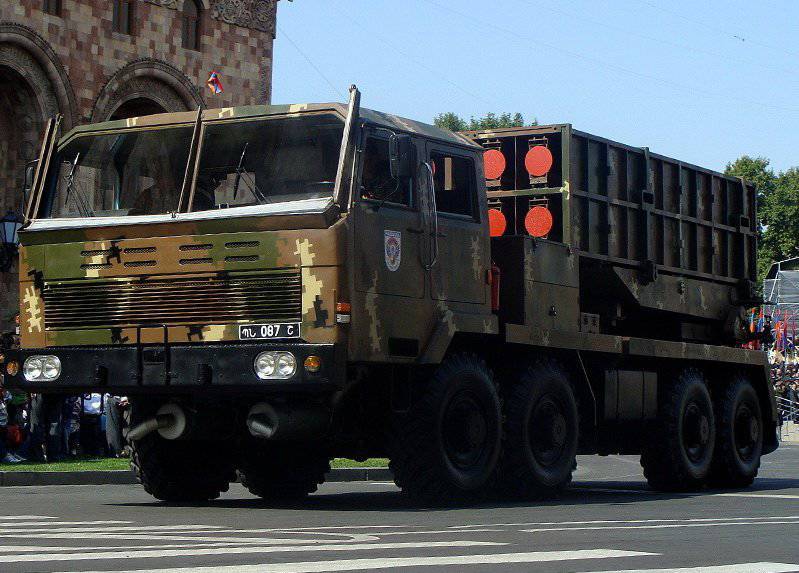
The selected chassis was originally equipped with a large cabin in which it was possible to accommodate even more than five people calculating the installation. In the back of the selected chassis placed launcher. Its swivel base rotated 20 degrees to the side of the car. Elevation angles were adjusted from 20 to 60 degrees. As in the case of the "Type 83", small pointing angles in the horizontal plane did not allow firing with small elevation angles - the cab of the vehicle was in the path of the missiles. A characteristic feature of the WM-80 launcher was the use of transport-launch containers. Before entering the position of the transport-charging vehicle (also on the TAS5380SQ chassis), using its own crane, installed two containers of four missiles each on the starting device of the combat vehicle. This method of recharge was chosen due to the relative simplicity and ease of use. The whole process of recharging the combat vehicle took no more than five to seven minutes.
For use on WM-80, unguided rockets of the 83 Type complex were modified. 273-mm ammunition was heavier by several tens of kilograms. The weight of the warhead remained the same. At the same time, due to the use of another kind of solid fuel, the maximum flight range has doubled. The range of firing system WM-80 - 34-80 kilometers. Missiles for this MLRS were the first time that Chinese designers tried to give this type weapons the possibility of accurate shooting. In addition to simple unguided rockets, an adjustable one was developed. The flight path correction system, according to most sources, worked with the help of satellite navigation systems, but there are references to an inertial system that commands out gas rudders in the initial part of the flight. Data on the accuracy of the adjusted ammunition was not published. For new projectiles caliber 273 millimeter was developed three combat units: high-explosive fragmentation, cluster and volume-detonating.
Tests of the MLRS began in the late nineties. WM-80 salvo systems are reportedly not adopted by the PLA. Nevertheless, a certain number of complexes went to the countries of the third world. Interestingly, several combat vehicles were subsequently resold to the United States, where they were carefully studied.
Later, in the two thousandth years, the WM-80 complex underwent a serious revision. Modernization received the designation WM-120. Changes, above all, were rocket and guidance systems. After all the changes, a new rocket with a trajectory correction system was able to fly a distance of 120 kilometers. Automatic guidance control systems not only updated, but also changed their composition. The staff of the MLRS WM-120 battery included a separate meteorological reconnaissance vehicle equipped with a specialized radar. In addition, all the calculations required for shooting are now made fully automatically.
There is currently no accurate data on the production and supply of the MLRS WM-120. There are fragmentary information about negotiations with Chile, Jordan and other third world countries, but there is still no confirmed information. Perhaps the WM-120 project is not yet ready for mass production: despite repeated demonstrations, the new Chinese MLRS has not yet been adopted.
A-100
Not having achieved the desired result with the first MLRS of the Weishi family, the Chinese military and engineers began another project. This time they decided to do the same as when creating the “Type 81”, with the difference that it was suggested not to fight off the sample for copying in battle, but to buy from third countries. In 1997, a number of Russian-made 9K58 Smerch was purchased from an unnamed country. All of them were transferred to the research organization CALT for the study and development on their basis of their own volley fire system. The prototype was described at the beginning of 2000.
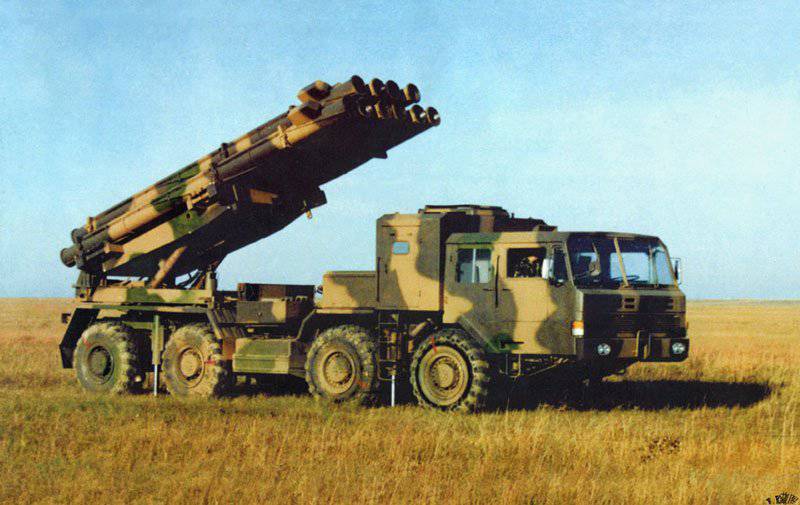
The combat vehicle of the new A-100 complex looks a lot like the original Smerch. So, the WS-2400 with the wheel formula 8х8 became the base for it, and the launcher design is a slightly reworked original unit. Unlike the Soviet / Russian, the Chinese MLRS has a slightly smaller salvo volume: the launcher is equipped with only ten tubular guides with an U-shaped slot for the initial promotion of a missile. The caliber of the guides and the rockets remained the same as on the Smerch - 300 millimeters. The combat vehicle is held in place during the shooting by four hydraulic outriggers. The same hydraulic system is used to guide the block guides. All operations are done by calculating the MLRS from the cab. If necessary, the functions of hydraulic cylinders can be performed by mechanics with manual transmission. After arriving at the position, the combat vehicles of the A-100 complex spend about six minutes to go into a combat position. After striking a strike (a volley lasts about a minute) for three minutes, the cars can go to the technical position, where the transport-charging machines recharge them.
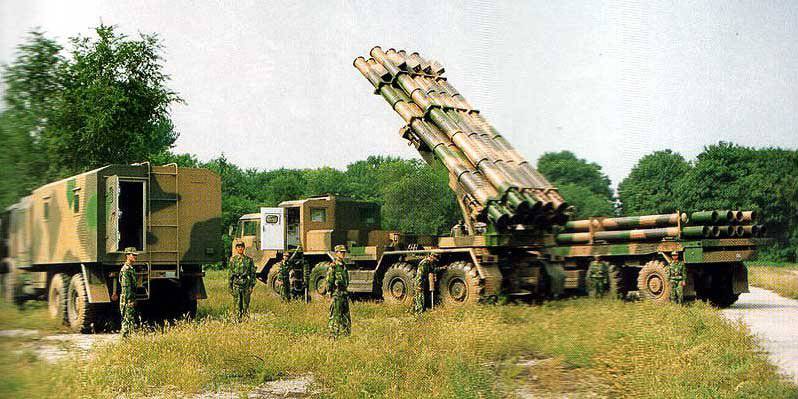
Missiles with a course correction system are used for firing. 840-kilogram ammunition is equipped with a warhead weighing about 235 kg. A comparatively powerful solid-fuel engine delivers loads from 40 to 100 kilometers. Missiles can be equipped with high-explosive fragmentation, incendiary and cluster warheads. Of particular interest is the system of correction of the flight path. The Chinese are not without reason taken as the basis of "Tornado". The fact is that its high firing range is provided by a special system designed to hold the rocket on the calculated trajectory. This system can not be called homing, but it provides a fairly high accuracy. Naturally, with the correct calculation of the direction to the target and the elevation angle of the launcher. Own equipment missiles complex A-100 during the first three seconds of the flight automatically determines the actual direction of motion, analyzes it and compares with the calculated trajectory. If necessary, commands are issued on the gas rudders, which allows you to withdraw ammunition in the right direction. After this correction, the control system does not interfere in the course of the flight, except in cases where the missile is equipped with a cluster warhead. When such warheads are used, the control system, at the estimated time, issues a command to open the cassette and eject submunitions. The stated deviation from the target is no more than 0,5% of the distance to the target.
For the accuracy of the guidance meets a separate fire control system. Each battery is given one machine with such equipment. The tasks of the control machine include determining the coordinates of battery combat vehicles, generating guidance information and transmitting it to missile control systems. The last stage of preparation for the volley is carried out "through the mediation" of the onboard equipment of the combat vehicles themselves. All pre-launch procedures related to the creation of a missile flight program take no more than one and a half minutes after arriving at the position.
In 2002, the A-100 system was adopted by the Chinese army. The total number of complexes produced is small - no more than a hundred. Small volumes of production are due, first of all, to the great complexity of production and the cost of both combat vehicles and rockets. In addition, A-100, having a long range, is in some way a special weapon designed to perform special tasks.
AR1A
In 2009, at the IDEX exhibition, NORINCO presented its new development, created, obviously, in the middle of the two thousandth. MLRS AR1A is a further development of the project A-100. It is noteworthy that this time the Chinese did not use other people's experience by buying and studying finished equipment. Employees of NORINCO completely legally and officially collaborated with the Russian National Research and Production Enterprise “Splav”, the leading Russian enterprise developing volley fire systems.
At the moment, the MLRS AR1A is a collection of the best practices of Chinese engineers. The combat vehicle uses a launcher, similar to the aggregate of the systems of the WM family: two separate containers of five missiles each are installed on its lifting boom. It is noteworthy that in order to facilitate the construction of the containers, they are designed as a frame frame with tubular guides mounted inside. To improve accuracy, the launcher has rotary devices that allow guides to be guided with an error of about one thousandth (about 0,06 °). In addition to the launcher on the combat machine is a cabin for all four people and equipment calculation. The latter allows you to collect and process the vast majority of the necessary information. Due to the correct selection of equipment, the combat vehicle of the AR1A complex is capable of independent combat work.
It is worth noting that an independent attack is still a tool "just in case." The main method of striking is the battery or division. In addition to the machines with the launcher, the compound consists of command-staff and transport-charging machines, as well as a separate car with a radar station, designed to collect data on meteorological conditions.
The 300 caliber millimeters of rockets were made in accordance with the Chinese military’s new views on the appearance of these munitions. Different warheads of missiles imply not only different actions on the target, but also characteristics that differ from each other. At the moment, the nomenclature of shells is as follows:
- BRE2. Corrected projectile with a range from 60 to 130 kilometers. High-explosive fragmentation warhead weighs 180 kilogram and hits targets within a radius of at least one hundred meters;
- BRE3. Adjustable projectile shorter range. Shooting is possible at a distance from 20 to 70 kilometers. The 200-kilogram cassette warhead is equipped with 623-cumulative fragmentation submunitions. Combat elements are scattered in a radius of up to 160 meters and punch up to 50 millimeters of homogeneous armor;
- BRE4. Missile with a cluster warhead and greater range: 60-130 kilometers. Equipped with combat elements similar to BRE3 submunitions, but in smaller quantities - 480 pieces.
To date, only a few AR1A complexes have been tested. This system of volley fire has repeatedly been interested in the military from different countries, but it is not yet offered for export. As for supplies for the Chinese army, they are worth waiting for in the coming years.
On the materials of the sites:
http://rbase.new-factoria.ru/
http://military-informer.narod.ru/
http://sinodefence.com/
http://articles.janes.com/
http://military-today.com/
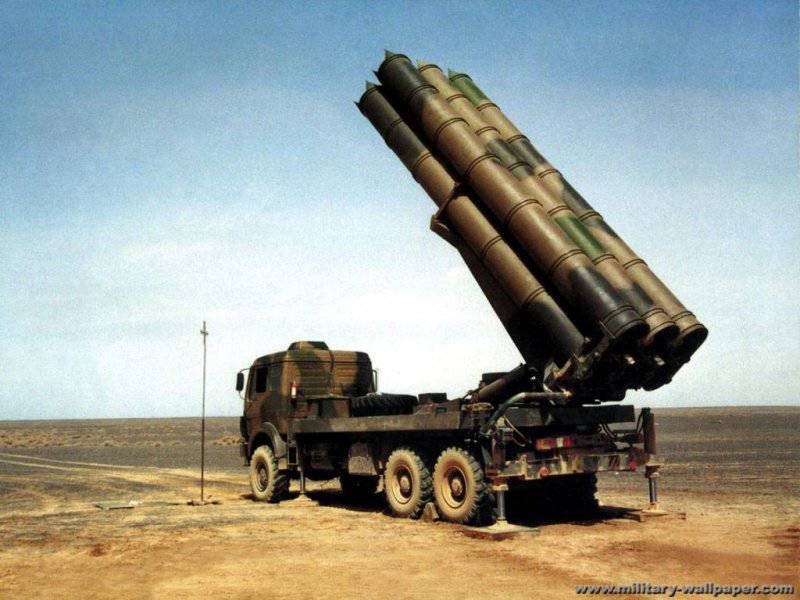
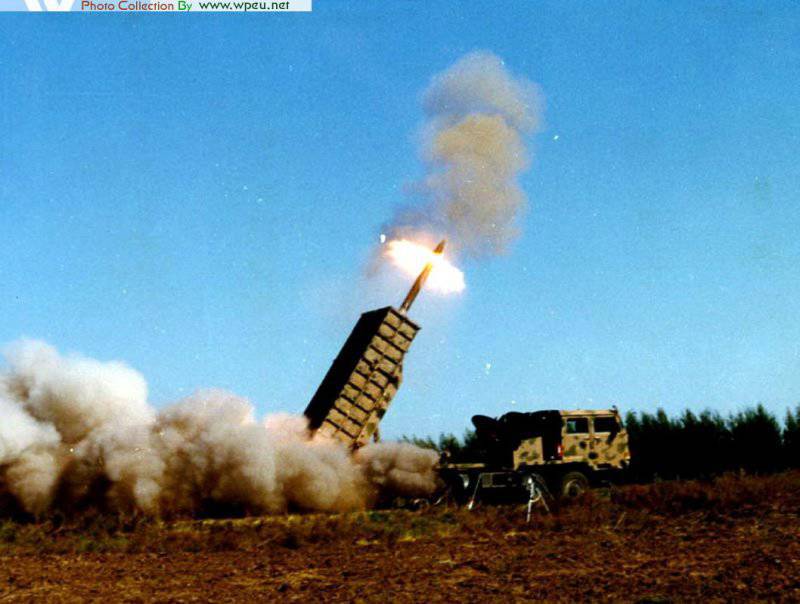
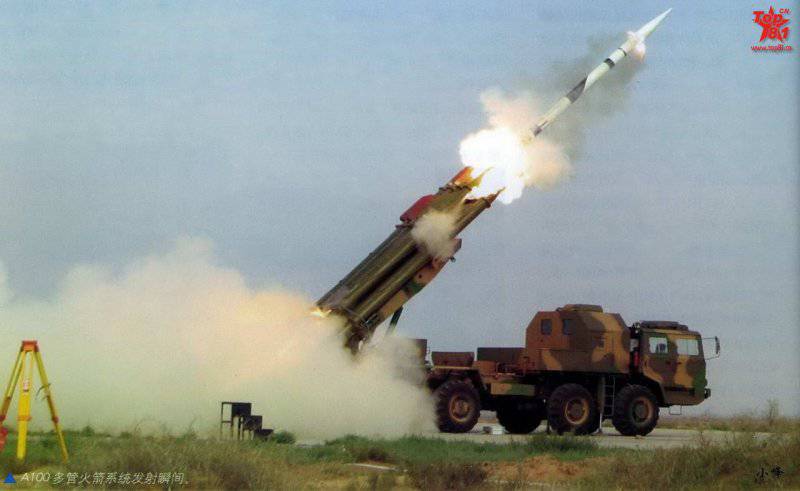

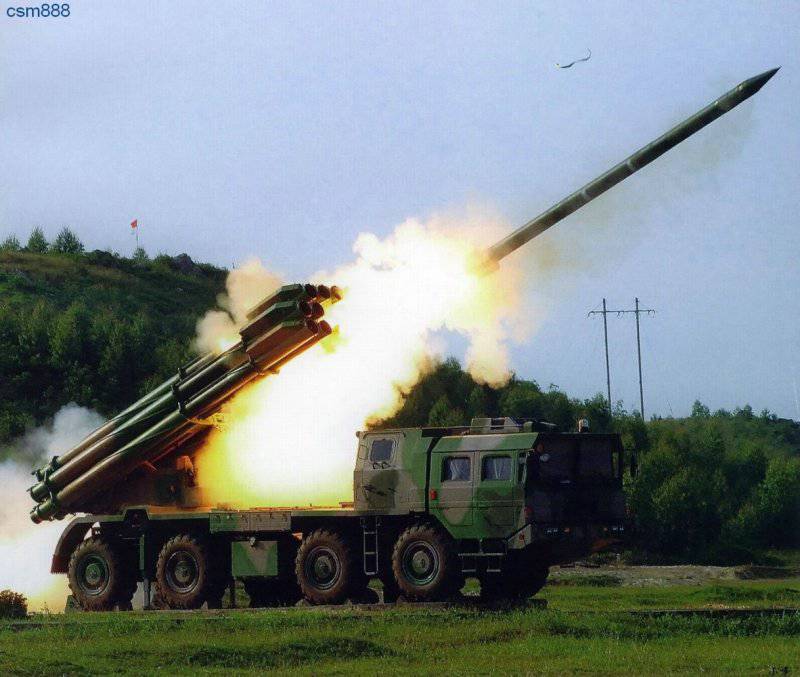
Information